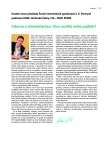Extended options of anticoagulant treatment in thromboembolism
Authors:
Debora Karetová 1; Jan Bultas 2
Authors‘ workplace:
II. interní klinika kardiologie a angiologie 1. LF UK a VFN, Praha, přednosta prof. MUDr. Aleš Linhart, DrSc., FESC, FCMA
1; Farmakologický ústav 3. LF UK, Praha, přednosta prof. MUDr. Jan Bultas, CSc.
2
Published in:
Vnitř Lék 2014; 60(11): 977-984
Category:
Reviews
Overview
Thromboembolic disease (TD) is a relatively common disease with acute risk of death and potential long-term consequences in term of postthrombotic syndrome or chronic pulmonary hypertension. Anticoagulant therapy is the basic therapeutic procedure; thrombolytic therapy and the introduction cava filter are appropriately indicated for individual cases. In past few years, new direct oral anticoagulant drugs (NOAC) have occurred – Xa factor or thrombin inhibitors which have demonstrated the same efficacy and even higher safety in comparison to conventional treatment. In mid 2014, 3 drugs of this group are registered in Czech Republic – rivaroxaban (Xarelto®), dabigatran (Pradaxa®) and apixaban (Eliquis®). These drugs have comparable efficacy and safety but they differ in schedule of dose administration. Rivaroxaban and apixaban can be administered immediately after diagnosis of venous thrombosis or hemodynamically stable pulmonary embolism. LMWH application has to precede few days the administration of dabigatran. Limitation of new drugs is their price. Unavailability of antidotes is temporary because current researches continue to find one for dabigatran and another for both of xabans. Duration of anticoagulant treatment after acute phase depends on the presence of thrombosis risk factors and the individual bleeding risk. Minimal duration of anticoagulant therapy is 3 months, commonly 6–12 months and in high risk patients it is “long term” treatment. Good results of new anticoagulant drugs in trials in term of thromboembolism recurrence prevention may change established habits in TD patients with long term treatment.
Keywords:
anticoagulant therapy – apixaban – dabigatran – deep vein thrombosis – new direct oral anticoagulants – rivaroxaban
Sources
1. Fahrni J, Engelberger P, Kucher N et al. Catheter-based treatment of ilio-femoral deep vein thrombosis – an update on current evidence. Vasa 2013; 42(3): 161–167.
2. Čížek V, Kučera D, Válka M. Kavální filtry. Postgraduální medicína 2010; 12(1): 83–89.
3. Kearon C et al. Antithrombotic Therapy for VTE Disease: Antithrombotic Therapy and Prevention of Thrombosis. 9th ed. American College of Chest Physicians Evidence-Based Clinical Practice Guidelines. CHEST 2012; 141(2 Suppl): e419S-e494S.
4. Van Dongen CJ, MacGillavry MR, Prins MH. Once vs twice daily LMWH for the initial treatment of venous thromboembolism. Cochrane Database Syst Rev 2005; (3): CD003074.
5. Goldhaber SZ, Piazza G. Optimal duration of anticoagulation after venous thromboembolism. Circulation 2011; 123(6): 664–667.
6. Schulman S, Kakkar AK, Goldhaber SZ et al. Treatment of acute venous thromboembolism with dabigatran or warfarin and pooled analysis. Circulation 2014; 129(7): 764–772.
7. Schulman S, Kearon C, Kakkar AK et al. Dabigatran versus warfarin in the treatment of acute venous thromboembolism. N Engl J Med. 2009; 361(24): 2342–2352.
8. Bauersachs R, Berkowitz SD, Brenner B et al. EINSTEIN Investigators. Oral rivaroxaban for symptomatic venous thromboembolism. N Engl J Med. 2010; 363(26): 2499–2510.
9. Büller HR, Prins MH, Lensin AW et al. EINSTEIN-PE Investigators. Oral rivaroxaban for the treatment of symptomatic pulmonary embolism. N Engl J Med 2012; 366(14):1287–1297.
10. Prins MH, Lensing AW, Bauersachs R et al. EINSTEIN Investigators. Oral rivaroxaban versus standard therapy for the treatment of symptomatic venous thromboembolism: a pooled analysis of the EINSTEIN-DVT and PE randomized studies. Thromb J 2013; 11(1): 21. Dostupné z DOI: <http://doi: 10.1186/1477–9560–11–21>.
11. Agnelli G, Buller HR, Cohen A et al. AMPLIFY Investigators. Oral apixaban for the treatment of acute venous thromboembolism. N Engl J Med 2013; 369(9): 799–808.
12. Hokusai-VTE Investigators. Büller HR, Décousus H, Grosso MA et al. Edoxaban versus warfarin for the treatment of symptomatic venous thromboembolism. N Engl J Med 2013; 369(15): 1406–1415.
13. Schulman S, Kearon C, Kakkar AK et al. RE-MEDY Trial Investigators. RE-SONATE Trial Investigators. Extended use of dabigatran, warfarin, or placebo in venous thromboembolism. N Engl J Med. 2013; 368(8): 709–718.
14. Schulman S. RE-MEDY; RE-SONATE Trial Investigators. Extended anticoagulation in venous thromboembolism. N Engl J Med. 2013; 368(24): 2329. Dostupné z DOI: <http://doi: 10.1056/NEJMc1304815>.
15. Agnelli G, Buller HR, Cohen A et al. AMPLIFY-EXT Investigators. Apixaban for extended treatment of venous thromboembolism. N Engl J Med. 2013; 368(8): 699–708.
16. Fox BD, Kahn SR, Langleben D et al. Efficacy and safety of novel oral anticoagulants for treatment of acute venous thromboembolism: direct and adjusted indirect meta-analysis of randomised controlled trials. BMJ 2012; 345: e7498. Dostupné z DOI: <http://doi: 10.1136/bmj.e7498>.
17. Becattini C, Agnelli G, Schenone A et al. Aspirin for preventing the recurrence of venous thromboembolism. N Engl J Med 2012; 366(21): 19591967.
18. Nicolaides A, Fareed J, Kakkar AJ et al.: Prevention and treatment of venous thromboembolism: international consensus statement (guidelines according to scientific evidence). Clin Appl Thromb Hemost 2013; 19(2): 116–118.
Labels
Diabetology Endocrinology Internal medicineArticle was published in
Internal Medicine

2014 Issue 11
Most read in this issue
- New aspects of hormone replacement therapy
- LDL-apheresis in the treatment familial hypercholesterolemia
- New SGLT2 inhibitor empagliflozin: modern and safe treatment of diabetes
- Extended options of anticoagulant treatment in thromboembolism
